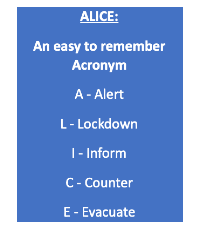
“Have you seen the news today?”
It’s a sunny day, and it started out perfectly normal. The alarm went off, and I got up to get a shower. After dressing, I made my coffee and drove into work. The whole day is ahead of me, and with it, the promise of great things.
This is how the day starts for most of us in the workforce. Maybe it will be rainy instead of sunny. Maybe your alarm goes off at 6PM instead of 6AM. But for most of us, each day holds the promise of great things. But not for everyone.
Somewhere across America, someone is waking up with a different plan. One that promises a very different start not only for himself, but for those around. Around 2 million people are victims of workplace violence every year. Anyone, anywhere can be a victim of workplace violence. However, some professions are more prone to violent outbursts. Employees in the service industries, those employees who handle money, and those who work alone and/or late at night have the highest risk.
With the Occupational Safety and Health Act of 1970, Congress created the Occupational Safety and Health Administration (OSHA) to assure safe and healthful working conditions for working men and women by setting and enforcing standards and by providing training, outreach, education and assistance. Each year we review our OSHA plan. We are updated on standards for blood-borne pathogens, chemical hygiene, labeling and regulated medical waste. But as times change, workplace violence has become a critical piece of this training. 1
Every employer must develop a comprehensive and effective workplace violence action plan. 2018 statistics show the average workplace is now 18 times more likely to experience an incident of workplace violence than a fire, and active shooters are becoming more likely. Training workers to protect themselves is one key element. Equally important is training employees to observe the signs in their co-workers and in the customers with whom they interact. 2
THE IMPACT OF WORKPLACE VIOLENCE ON HEALTHCARE AND SOCIAL SERVICE
Healthcare and social service workers face a significant risk of job-related violence. The National Institute for Occupational Safety and Health (NIOSH) defines workplace violence as “violent acts (including physical assaults and threats of assaults) directed toward persons at work or on duty.” According to the Bureau of Labor Statistics (BLS), 27 out of the 100 fatalities in healthcare and social service settings that occurred in 2013 were due to assaults and violent acts.
While media attention tends to focus on reports of workplace homicides, the vast majority of workplace violence incidents result in non-fatal, yet serious injuries. Data shows that the majority of injuries from assaults at work that required days away from work occurred in the healthcare and social services settings.3
IDENTIFYING AND ASSESSING WORKPLACE VIOLENCE HAZARDS
Violent behavior of patients, clients or residents put healthcare and social service workers at an increased risk of work-related assaults. While no specific diagnosis or type of patient predicts future violence, studies demonstrate that inpatient and acute psychiatric services, geriatric long-term care settings, high volume urban emergency departments and residential and day social services present the highest risks.
Risk factors fall into several groups ranging from patient and facility to organizational and environmental factors. Many of these risk factors include common sense risks such as dark corridors, isolated areas, working alone in a patient home and working with limited communication. Organizational risk factors such as short staffing, overworked employees and failing to properly educate employees regarding risk also contributes to violence hazards. 4
Waiting for an incident to occur is the wrong time to assess your risk for workplace violence. It is important that you assess things like your safety policies and procedures and your building’s safety risks. Your safety policy should include tips to recognize individuals who are exhibiting signs of workplace violence or who might be a high risk of experiencing workplace violence, etc. 5
Some common signs that workplace violence is occurring include but aren’t necessarily limited to:
VIOLENCE PREVENTION PROGRAMS
As part of the commitment to OSHA, each workplace should have a program in place for education and awareness of workplace violence risks and hazards. A workplace’s violence prevention program should have clear goals and objectives for preventing workplace violence and be adaptable to specific situations and specific facilities. Employees should be trained upon start of employment, and the training should be reinforced annually. Employees should have access to a reporting mechanism for any event, regardless of physical assault or verbal, written or cyber threat. The program should be reassessed regularly to see that goals are met.
TYPES OF WORKPLACE VIOLENCE
Workplace violence is categorized in 4 major groups.
MANAGEMENT APPROACHES TO WORKPLACE VIOLENCE PREVENTION
Administrative Management
Security Management

RESPONDING TO VIOLENCE IN THE WORKPLACE
The first response to a violent customer, coworker or visitor may make all the difference in the outcome of the incidence.
If de-escalation does not work or in the event of threat with guns and other weapons, more active approaches may be needed. The traditional method of “lockdown only” response has proven to be ineffective in certain situations. With this approach, targets become easily identifiable and makes the aggressors mission easier.
National training organizations, such as ALICE, instruct on practical techniques for better barricades, use of mobile and electronic devices, communication with police and using your lockdown time to prepare for other strategies, i.e. counter and evacuate. 9

CONCLUSION
The key to a safe and healthful work environment is a comprehensive injury and illness prevention program. Information on workplace violence, including identifying risks, prevention, management, and response are key elements to providing a safe and healthy work environment. Thousands of employers across the United States already manage safety using training programs, and all employers can and should do the same. Most successful safety programs are based on a common set of key elements. These include management leadership, worker participation, hazard identification, hazard prevention and control, education and training, and program evaluation and improvement.
References:
1., 3., 4., 5. Guidelines for Preventing Workplace Violence for Healthcare and Social Service Workers U.S. Department of Labor Occupational Safety and Health Administration OSHA 3148-06R 2016
2. Employers Must Create Workplace Violence Action Plans, By Jessica Davis
Jun 07, 2018; https://ohsonline.com/articles/2018/06/07/employers-must-create-workplace-violence-action-plans.aspx
6. Understanding—and Preventing—Workplace Violence, By Kelly Creighton Aug 13, 2018 EHS Management, Emergency Preparedness and Response © 2019 BLR®—Business and Legal Resources 100 Winners Circle, Suite 300, Brentwood, TN 37027 800-727-5257
7., 8. Five Management Approaches to Workplace Violence Prevention, Psychology Today; Posted Feb 19, 2017